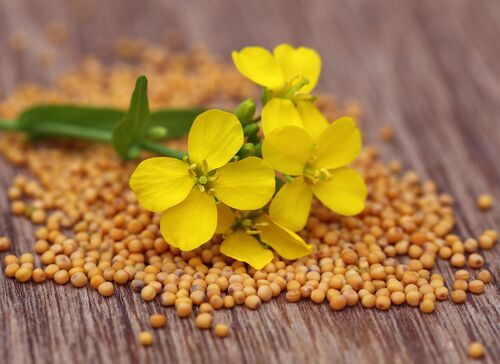Sowing and Growing Yellow Mustard

Yellow mustard is an easy-to-grow, fast-growing plant, which can reach a height of one meter. The plant blooms with yellow flowers and resembles the plant of rapeseed. Yellow mustard can be grown for its seeds, from which mustard can be made. But the plant is also grown as green manure.
Growing yellow mustard from seeds
There are different types of mustard seeds, such as the black, white and yellow. The yellow one is used for making mustard because of its strong flavour. This is also the variety that is used as a green manure. Yellow mustard, also called Sinapis alba, belongs to the cruciferous family and is easy to grow.
Sowing and planting of yellow mustard
When yellow mustard should be sown depends on the purpose. For harvesting the seeds, sowing can be done in March and April. The harvest then falls in September.
If the plant is used as green manure, it can be sown from March to September.
When sowing early, the plants must be pruned before seed is produced. Sowing late, in September, the season is too short and the plant will no longer produce seeds. The plant freezes to death in winter and can be incorporated into the soil. Sowing can be done in rows, with a planting distance of about 5 x 30 cm. The seeds can also be spread on a prepared field.
Position and soil for growing Yellow Mustard
Yellow mustard likes a sunny spot in the garden and can be grown in any type of soil. It demands little from the soil.
How to care for your yellow mustard plants
Yellow mustard is an easy to grow plant. It needs little water and not much fertilizer either. Depending on the purpose of the crop, additional nutrients can be given. Such as phosphorus if the plant is grown for the seeds or nitrogen if the plant is used as green manure.
When and how to harvest yellow mustard?
The seeds of the yellow mustard can be harvested from July to September. This depends, among other things, on when the seeds were sown. The best way to harvest the seeds is to leave them on the plant for as long as possible. When the plants are completely dead and withered, they can be pulled out of the ground and hung upside down to dry further. After that, the seeds can be harvested. Do this by shaking the twigs well. The leaves can also be eaten and has a slightly spicy mustard flavour.
How to preserve yellow mustard
Yellow mustard can be stored for years, provided it is properly dried and stored in a tightly sealed jar.
Is yellow mustard healthy?
Both the leaves and seeds of the yellow mustard can be eaten and are healthy. It contains many vitamins, such as A, B, C, E and K, minerals, such as calcium, phosphorus, potassium, manganese, selenium and zinc, and omega 3 fats. Several medicinal properties are attributed to yellow mustard seeds. It is said to lower blood pressure, promote digestion, help with muscle aches and headaches and skin infections.
Yellow mustard seeds in our collection
We have several types of yellow mustard seeds in our range, both the green manure and the herb variety.
Tips to grow yellow mustard
Harvesting the seeds can be a daunting task. Therefore, let the plants, with the seeds, dry well. This will release the seeds more easily and makes it easier to shake them off the plant.



